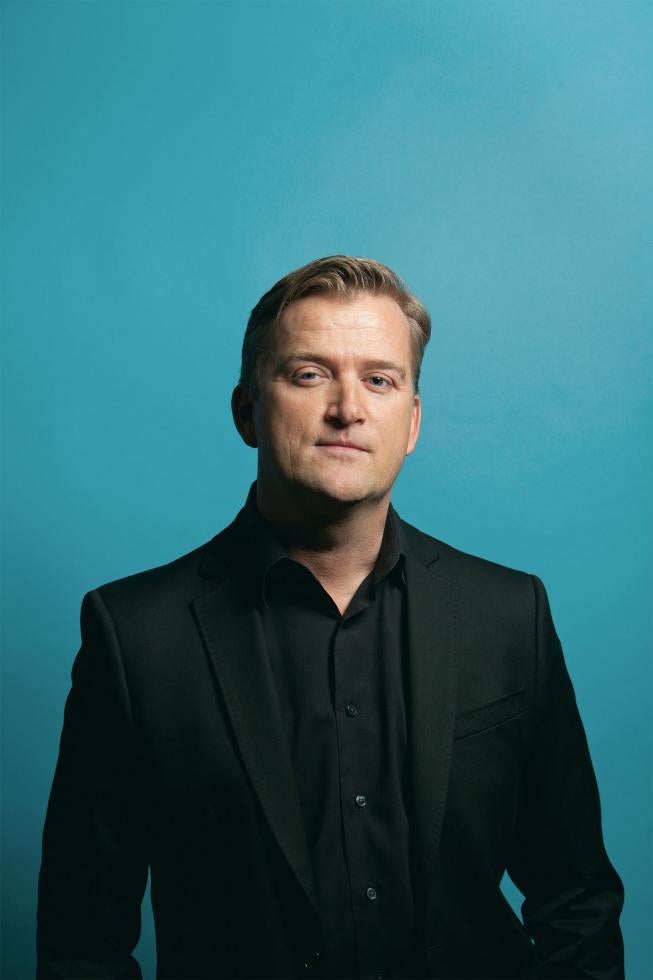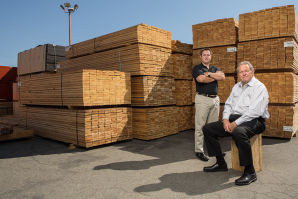Bonney Plumbing CEO Jimmy Crabbé

Think of it as The Deodorant Problem. If you’re marketing a brand, it’s easy to sling the sex appeal of wine, cars or a hot new phone. These things are aspirational. They sell themselves. But what if the product is a tad mundane and even a little stinky? How do you convey the emotional appeal of, say, unclogging a toilet?
If you’re Jimmy Crabbé, the new CEO of Bonney Plumbing, you crack this problem with an inspired move that no one saw coming: scoring the naming rights to the home stadium of Sacramento’s Republic FC, flipping the brand-association from sewage, pipes and leaks to growth, excitement and community. Then you stumble into a bit of luck: The team wins the opening match at Bonney Field, sells out every game, makes the playoffs, then trounces the Harrisburg City Islanders to win the championship, sparking something of a soccer renaissance in Sacramento.
And there, at the center of it all, is the little plumbing company that could. Founded in 1978, its full name is actually Bonney Plumbing, Heating, Air and Rooter Service — a title not even Don Draper could sexify.
But you don’t need sex appeal to grow. Bonney Field has served as a vindication of sorts for the operations-focused Jimmy Crabbé, it’s breathing new life into a once-stodgy brand and it’s even helping Sacramento’s bid to land a Major League Soccer franchise.
The Fixer
There has never been and will never be a Hollywood blockbuster about logistics. The cameras chase the inventors, the artists, the tortured visionaries. They tend to overlook the Jimmy Crabbés of the world. Yet his career is a case study in how quiet competence can spur electric growth, how the tiny details matter and how operations can swing a company’s fortunes. Born and raised in Belgium, Crabbé thought he’d be a soccer star — at 18, he played goalie for Belgium’s largest pro club — but an injury killed that dream, routing him to the more conventional path of college, with a focus in mathematics and international business.
“I always looked at the bigger picture,” Crabbé says, “even from a geographic standpoint. Belgium was too small a piece of the puzzle.”
His first job out of school was with Fritz, a logistics company that gave him a crash course in operations. Fritz gobbled up smaller companies, and Crabbé helped manage the growth, working with the new acquirees to ensure a smooth transition. (He was the seventh employee hired in Europe; that team quickly grew to 1,600.) Fritz’s corporate headquarters in San Francisco plucked Crabbé from Belgium for a turnaround project expected to take two years. He did it in one.
“I had started to build a reputation as a crisis manager,” says Crabbé, almost reluctantly, clearly uncomfortable talking about his career achievements. Six months after he moved to the States, Fritz was purchased by UPS, effectively bumping Crabbé from the minors to the big league.
Crabbé didn’t disappoint. “The Southwest Region was a real problem child at the time; it was UPS’ largest loss-making business unit,” he says. UPS deployed him to Atlanta to right the ship, and in less than a year it became “one of the most productive regions, and it put my UPS career on the fast-track.” The brass fed him more responsibility, and at age 35 he was the VP of East Coast operations, managing logistics for 22 states and 1,200 employees.
“I wish I could say that I woke up one day and chose to buy a plumbing company, but that’s not really how it happened.” Jimmy Crabbe, CEO, Bonney Plumbing
At most companies, the ho-hum job of logistics hides behind the sizzle of marketing, product development or even R&D. But this is UPS. Logistics is the star. (On its website, the splash page says simply “We ♥ Logistics.”) UPS began its existence as a simple package delivery company, but this model had only so much capacity for growth. So, understanding a thing or two about transportation, it scooped up companies left and right — warehouses, ocean freighters, tech companies, even banks that could provide its clients with financing options. And Crabbé was often the point-person. He was tapped as VP of the Global Ocean Trade Project, helming 1,800 employees in 100 countries, and once again he transformed a loss-leader into a productive slice of the company. The man had a gift. He was on the corporate fast-track.
What’s the Encore?
Plumbing.
“I wish I could say that I woke up one day and chose to buy a plumbing company, but that’s not really how it happened,” says Crabbé, who was contacted in 2011 by the original Bonney owners, husband and wife Mark and Candace Bonney, the beloved couple whose faces you’ve seen plastered on all the company vans. The owners had a gut sense they weren’t squeezing out the company’s full potential, and if Crabbé could turn around UPS’s most troubled divisions, maybe he could do the same for them.
Crabbé was intrigued. After weeks of negotiations came the moment that clinched the deal: Mark Bonney showed Crabbé his fleet of trucks, and Crabbé says, “I could see the spark in his eyes when he talked about how clean his trucks are — not just on the outside but on the inside. It gave me a warm-and-fuzzy.”
But he didn’t buy the company for sentimental reasons. He saw growth. Whereas a layman may see only pipes and boilers, Crabbé sees ways to build a better mousetrap. Take an example like, say, truck logistics. “We had an extremely high truck inventory, which let us go to houses and fix the problems right away,” says Crabbé. “But we started analyzing how many of these parts we were actually using, and we asked, ‘Is it possible to reduce the inventory without hurting the customer experience?’ We found the under-performing parts, we took them off the trucks and this freed up the cash flow.” He repeated the trick with bar code technology, scanning and the supply chain.
He’s also hunting for new revenue streams. Just as UPS began as a mere package shipper, Bonney started with plumbing but later added heating, air conditioning, sewage and draining service. Now, in 2015, Crabbé sees growth in two key services: water quality and water conservation. “Water is to a home what blood is to our bodies,” he says, somehow making plumbing seem poetic. “It runs through our veins and keeps everything functioning. If the quality of the water is not good, it’s going to result in failing pipes. So we can provide options to the client. Most people do not know how water quality affects them and their home. There are so many simple solutions that we can provide.”
The early returns? Since he took the reins in 2012, Bonney has doubled its staff — and its revenue.
The Pitch for the Pitch
It’s tempting to think that since Crabbé once dreamed of being a soccer star, he splurged for the naming rights in a Jerry Jones-esque moment of wish fulfillment, thereby bringing his life full circle. “To be honest, it could have just as easily been ice hockey,” he says. “The opportunity would have been the same. The fact that it’s soccer is a bonus.” Crabbé met with Republic’s ownership in December 2013, at first talking about a more modest T-shirt sponsorship, then joked to club President Warren Smith, “Maybe we should just name the stadium?”
“I fell in love with Sacramento. I really did. And I certainly wasn’t expecting that.” Jimmy Crabbé, CEO, Bonney Plumbing
“Soccer is all about the community,” Smith says. “Our client-base is their client-base. The general public, the fans, the families — it’s a great demographic for them.” It also helps that they’re, well, plumbers. “We were really struggling on some of the construction-related issues, like the plumbing of the locker rooms. So Bonney threw its staff at it and got it done. Frankly, without them, we wouldn’t have been able to open Bonney Field on time.”
Warren is laser-focused on bringing MLS to Sacramento and says “one of the requirements [for the MLS] is that we have to prove that we can get corporate sponsorship and generate revenue with a stadium. Bonney has helped with all of that.”
Okay, that’s all nice and all, but let’s cut to the quick: How do we know if it pays off? Yes, the stadium does provide a hook for Bonney to blast Instagram photos with tags like, “It’s half-time. We lead 1-0. Stay tuned for the @MyBonney toilet kick!” But does this sort of thing recoup the investment? Crabbé is, by his own words, a man of numbers. He loves stats and metrics. Quantifying the cash-flow from trucking inventory is one thing, but how do you calculate the halo effect from naming rights?
The New York sports consulting firm 21 Marketing tried to calculate the return on investment from naming rights of fields like Lucas Oil Stadium ($6 million annual fee), Sun Life Stadium ($7.5 million) and Reliant Stadium ($9.4 million), finding that in almost all cases, even when the contract is lucrative (Citi Field: $20 million), the benefits outweigh the costs. Your logo is always seen on camera, your company is suddenly a household name and you tend to attract more media like, well, articles like this. It’s also possible to track the exposure. Bonney asks every customer, ‘How did you hear about us?’ — giving it the ability to measure the stadium’s impact.
The stadium allows Bonney to do more with community outreach, like a Make-a-Wish Foundation campaign that allowed a terminally ill child to join the team on Bonney Field. It also helps the company reach a younger demo: “Since partnering with Sacramento Republic, we have found more recognition with new homeowners and young families,” says Holly Gormsen, Bonney’s director of marketing.
And there’s also a sneakier benefit to the stadium rights: free focus groups. Crabbé attends every game and speaks to as many customers as he can. “This allows our marketing team to get a massive amount of customer feedback in a very short amount of time,” he says. “Nobody’s perfect. And it’s OK to make mistakes. But it’s not OK to not learn from those mistakes. You’ve got to be humble, you’ve got to go through that 5-step process again and again, based on financial trends and customer feedback.”
“We’re a growing company. So maybe someone says that our hold times are too long — OK, do we need more staffing? Is there a process-improvement opportunity? And obviously you’re going to find people who say they paid too much, but was the value explained properly? Did the technician explain what they’re doing and why they’re doing it? That’s an ongoing project we have.”
The bigger ongoing project, however, has nothing to do with valves or pipes. It’s about Sacramento itself. “Years ago, I was nervous about moving to Sacramento. The city, to me, was never a destination. My wife comes from New York, and I’ve lived in multiple metropolitan areas. I worried … how were we going to adjust to Sacramento? What’s there to do?”
He pauses.
“Then I moved here. And I fell in love with Sacramento. I really did. And I certainly wasn’t expecting that. Many people see Sacramento as an enabling city, meaning that it enables you to go to San Francisco, Lake Tahoe, Napa.” He no longer sees it like that. “Sacramento is a destination. We just need to do a better job communicating that. This is my personal challenge — how can I help contribute to turning Sacramento into a destination? It has everything — the art world, sports scene, museums.”
And now, with any luck, maybe the city will be known for its world-class plumbing.
Recommended For You

Mind Games
Tech darling Mark Otero hit it big, then almost hit restart
Bright orange walls and ergonomic chairs. A black conference table flanked by a half-dozen scruffy-chic men (zip-front sweaters, double-pierced ears, turn-of-the-millennium tattoos) and three times as many digital devices (nobody brought just one).

On the Cover: The World’s Fastest Man
Rome wasn't built in a day, because C.C. Myers didn't have that contract
Construction guru C.C. Myers has, for more than two decades, been California’s go-to guy when roads are ravaged by acts of God (like the ’94 Northridge earthquake) or the toll of time (Folsom’s Lake Natoma Crossing, Interstate 5 in Sacramento, Route 99 in Turlock, the Walnut Creek Interchange, and the list goes on). The New York Times once called him the “Miracle Worker Highway Man.”

Star Power to Ignite Sac Soccer
Owners hope new investment lineup will boost city's chances of going MLS
The Sacramento Republic FC has bolstered its quest to become a Major League Soccer franchise. On Monday the team announced an impressive addition of more than a dozen new business leaders who will invest in the group, including Ultimate Fighting Championship fighter and local business owner Urijah Faber.




Comments
Fantastic article! Love the humility and reflection!